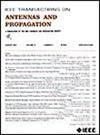Single-Layer Rectenna Array With Integrated Matching Circuit for Wireless Power Transfer
IF 4.6
1区 计算机科学
Q1 ENGINEERING, ELECTRICAL & ELECTRONIC
引用次数: 0
Abstract
This article reports an efficient single-layer rectenna array at 5.8 GHz. The patch antenna is directly matched to the Schottky diode impedance by a high impedance transmission line without extra matching circuit. By controlling the width and length as well as position of the transmission line, good conjugate matching can be achieved. Not only the size, but also the insertion loss of the matching circuit can be reduced. And each patch is connected to 4 Schottky diodes to enhance the power handling capability which is attractive in the long-distance high power wireless power transfer (WPT). The dc power combining circuit is connected to the patch at the center of the short edge where dc current can pass and the RF current is zero. The whole rectenna array only has one layer which makes it has lower cost compared with its multi-layer counterparts. To verify, a rectenna element is studied first. The single element rectenna achieves 73.1% RF-to-dc power conversion efficiency (PCE) at 5.8 GHz. When the array is loaded with带集成匹配电路的单层整流天线阵列无线电力传输
本文报道了一种5.8 GHz的高效单层整流天线阵列。贴片天线通过高阻抗传输线直接匹配肖特基二极管阻抗,无需额外匹配电路。通过控制传输线的宽度、长度和位置,可以实现良好的共轭匹配。不仅可以减小尺寸,而且可以减小匹配电路的插入损耗。每个贴片连接4个肖特基二极管,以提高功率处理能力,这在远距离高功率无线电力传输(WPT)中很有吸引力。直流功率组合电路连接在短边中心的贴片上,直流电流可以通过,射频电流为零。整个整流天线阵只有一层,与多层整流天线阵相比成本更低。为了验证,首先研究了一个整流天线元件。单元件整流天线在5.8 GHz时实现73.1%的RF-to-dc功率转换效率(PCE)。当阵列加载$2.5~\Omega $时,$6\ × 5$整流天线阵列产生2.34 W的直流输出功率,rf -dc转换效率为69.4%,入射功率密度为9.37 mW/cm2。给出了输出直流功率随入射波入射角变化的计算方法,计算结果与实测结果吻合较好。
本文章由计算机程序翻译,如有差异,请以英文原文为准。
求助全文
约1分钟内获得全文
求助全文
来源期刊
CiteScore
10.40
自引率
28.10%
发文量
968
审稿时长
4.7 months
期刊介绍:
IEEE Transactions on Antennas and Propagation includes theoretical and experimental advances in antennas, including design and development, and in the propagation of electromagnetic waves, including scattering, diffraction, and interaction with continuous media; and applications pertaining to antennas and propagation, such as remote sensing, applied optics, and millimeter and submillimeter wave techniques

 求助内容:
求助内容: 应助结果提醒方式:
应助结果提醒方式:


